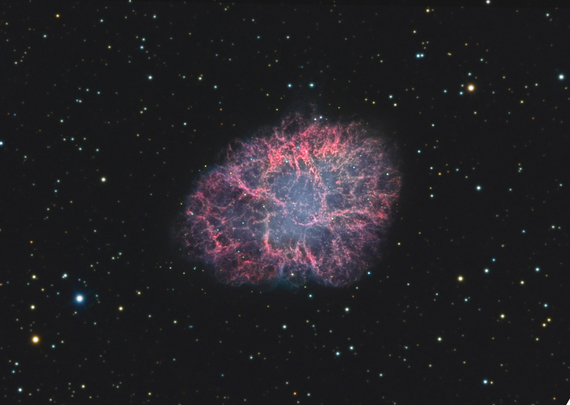The Crab Nebula
 Click Image for full size view Warning: Full size images can be very large |
By |
Catalog |
Obj Type |
Location |
Date Taken: |
SSRO |
Messier 1 |
Planetary Nebula |
Mayhill, NM |
01-24-2007 |
Description |
||||
M1 was discovered by 1731 by British amatuer astronomer John Bevis. The Crab Nebula is the most famous and conspicuous known supernova remnant, a cloud of gas created in the explosion of a star as a supernova. This supernova was noted on July 4, 1054 A.D. by Chinese astronomers, and was about four times brighter than Venus, or about magnitude -6. According to the records, it was visible in daylight for 23 days, and for 653 days to the naked eye in the night sky. It was probably also recorded by the Anasazi Indian artists (in present-day Arizona and New Mexico), as findings in Navaho Canyon and White Mesa (both in AZ) as well as in the Chaco Canyon National Park (NM) indicate; there's a review of the research on the Chaco Canyon Anasazi art online. In addition, Ralph R. Robbins of the University of Texas has found Mimbres Indian art from New Mexico, possibly depicting the supernova. Steve Mazlin created the image above by combining four hours of high-resolution Ha taken with the STL-11000M camera on January 24, 2007 with the color from Rick's HaRGB (260:60:60:60 minute) image taken using the old ST10XME camera on November 11, 2004. Another new wide-field version of M1 taken using the STL-11000M camera on December 26, 2006 can be seen by clicking here. This image is also an HaRGB combine with 11 hours of Ha data and 16 hours of RGB data.
|
||||
Technical Details |
||||
Exposure Time: |
HaRGB (240 : 60 : 60 : 60 minutes) | |||
Camera: |
SBIG STL-11000M | |||
Telescope: |
RCOS 16 inch f/8.7 Ritchey-Chretien | |||
Mount: |
Software Bisque Paramount ME | |||
© 2025 SSRO Used with permission, No reproduction of these images are permitted without written approval from SSRO. |
||||
